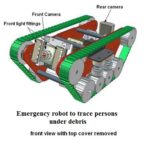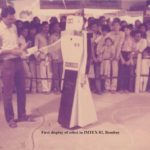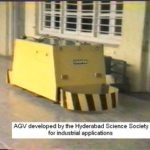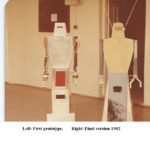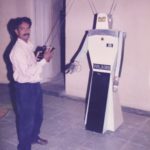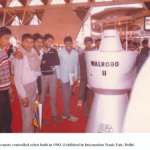We will go back to the pre-1980’s situation in India and the existing state of technology – as faced by the Hyderabad Science Society (HSS). Established in 1948, it was – and probably still is – the only voluntary organization in India with an active programme in science R&D.
It is not generally know that the HSS played a significant role in introducing digital technology in the country – through the development of digital electronic instruments, and training courses in digital electronics – the courses being supported by the GOI, Electronics Commission and the Dept. of Electronics. It was not till later 1980’s that PM Rajiv Gandhi was forcing the railways, LIC etc. to convert to digital technology – using digital computers to start with.
Apart from mechanical engineering and digital electronics, sensors play a crucial role in robotics technology. The first Report on Sensors was prepared by the HSS on the request of the GOI, Dept. of S&T.
When the initial work started to develop a remote controlled robot, the major problem was the lack of some vital components and hardware. Items like DC motors, re-chargeable batteries and radio control systems were not available at all. In the first robot developed at HSS, we used DC motors from the surplus market in USA. Rechargeable batteries and radio control systems had to be imported from UK and Japan. The design of the first and the second robots had to be centred around the hardware readily available – the most important of these being the DC motors for locomotion, arms and the grippers.
When the first robot was displayed in IMTEX 82, Bombay, it was given wide publicity since no one had seen a humanoid robot in India. Within three days the crowds that came to witness the robot moving about, distributing flowers to the audience in a specially erected platform, went out of control and the display was temporarily halted. The organizers of IMTEX informed us that complaints had been received from other exhibitors that the robot was attracting too many viewers to their neglect. The robot’s display was shut down two days before the final day of the IMTEX.
The second and more advanced robot was displayed in 1983 in Delhi at the International Trade Fair, attracting the attention of the President, Shri Zail Singh also.
Media coverage, including telecast – gave wide publicity to these developments, the bringing the activities of the HSS to the notice of their readers and viewers. This resulted in large organizations contacting the HSS for developing robots for their own specific applications. Some of these are mentioned below, with reasons why the projects did not materialize.
- Bhilai Steel Plant: The management was very keen to enlist the help of the HSS in providing robots for some of their applications. The project was later withdrawn due to severe opposition from their workers’ Union.
- BARC: On their request, a demo was arranged in the HSS to show how a remote controlled robot could be employed to suck heavily radiated – and very costly – Heavy Water which had leaked from nuclear reactors in Tarapore and elsewhere on to the floors. However, in spite of the recommendation of their Robotics Group leader, who had witnessed the demo, to award this project to the HSS, their Director did not agree to involve HSS in this matter; reportedly stating that since he had seen how this could be done, the BARC Robotics group should do this on their own. They could not.
- CSIR CMERI: A task force was set up some years back to develop a robot to clean reactor pipes which were getting clogged. The HSS was contacted by the Director CMERI and a group of their scientists sat with the HSS group in Hyderabad for five days during which the specs of the proposed robot and the basic designs were worked out. The area of development to be carried out by the HSS was also marked out. However, reportedly, the higher ups wanted to keep the HSS out of this project and the work started with other groups. After spending a large amount of money- and time – the project could not be completed and was wound up.
These above incidents are for your personal information
Automatic Guided Vehicles (AGVs)
In this area also, the HSS took the initiative and developed a toy AGv which was exhibited for the first time in the Industrial Exhibition in Hyderabad.
This display was also witnessed by the CMD of Semiconductor Complex Ltd (SCL), near Chandigarh, who sponsored a project in HSS to develop an AGV to transfer material from their outdoor warehouse to their wafer fab labs. The AGV, with a payload of 50 KGs, was developed within the scheduled time, but before its delivery, the whole of SCL was destroyed in a massive fire accident.
The Walchandnagar Industries Ltd, Machine tools Dvision, Pune, funded the HSS to develop a large AGV, weighing 1 ton – including a payload of 500 KGs. The docking had to be precise – within 5 mm – at the docking stations. This was developed and given over to them.
Swiss agreement: Switzerland, famous for precision engineering, approached the HSS to jointly develop AGVs. A MOU was signed in Switzerland with the E’Cole Technique St. Croix between their Director and the Director HSS in front of the Mayor, St. Croix, and the President, HSS.
This project did not take off due to unfortunate circumstances, as well as the lack of support from the Dept. of Electronics. Two years after this, a group of forty Swiss technical Teachers visited the HSS to see the activities of the HSS in the area of robotics.
More recent development in robotics at the HSS include:
- Development of a prototype robot to locate persons trapped under debris from natural and unnatural causes.
- Surveillance robotic vehicle developed for Border Security Force to monitor the LOC in Jammu area – on the request of the GOI, Home Ministry
- Robotic vehicle for sanitising roads and parks near Covid -19 affected areas.
I have briefly described some of the activities of the HSS since 1980 – over a period of forty years – under my initiative.
If there are any specific questions or any further information desired, feel free to comment below.






